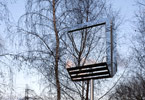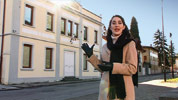Trajector Art Fair
Moody presents artworks by eight artists' based in Ireland and the UK at Trajector Art Fair, Brussels. Trajector is situated in the city centre located Hotel Bloom and each curatorial project or gallery taking part exhibits their selection of works in separate bedrooms.
The rented hotel room promises it's occupants a temporary space of remove. The opportunities to role play, plan, contemplate or fantasise are embedded within this space of relative anonymity. In the 2008 Argentinian film, 'Historias Extraordinarias' directed by Mariano Llinás the character 'X' retreats into hiding for months on end to a single hotel room after witnessing a murder and stealing a briefcase from the scene of the crime. Throughout his fear fuelled time in this one room, he distracts himself from the evidence at his disposal, the locked briefcase, by concocting stories and conspiracy theories extrapolated from what he sees through his window and learns from the daily news. 'X' inhabits his own comprehension of what is known and what is concealed, melding the personal with the general, outside with inside, past with present, facts with fantasy. It is these amalgamations that resonate throughout the artworks in Moody's exhibition at Trajector as the private hotel spaces are for one weekend made public.
In Michelle Deignan's 'Il Cittadino' an actor filmed in Friuli Venezia Giulia in the north east of Italy, performs a series of speeches to camera. Barely inhabited locations, a sparse soundtrack with sporadic uncanny camera perspectives frame the presenter's self-conscious style of delivery. Throughout the work this character transforms from the reliable, assured carrier of fact associated with news media into an obsessive collector and regurgitator of information, as she relentlessly delivers a narrative that meanders almost inappropriately from the humorously confessional to the directly political.
Tom Molloy's pencil drawing 'Aftermath No. 7', drawing on photograph, 'Graven No.2', and photograph 'Contact' directly address media representation of violence and trauma resulting from international conflicts. Focusing on the role of photography in the creation of iconic images of horror and distress, Molloy's scrutinises the ramifications of the photographic document in the representation of "The Other". The underlying ethics of authoritative and seemingly objective imagery are also addressed in Suzanne Mooney's work. The vinyl on mirror piece from the series 'Make love to the camera' that she has made specifically for Trajector, uses imagery adapted from schematic representations found in photo-manuals on nude photography. ‘Make love to the Camera’ playfully exposes the values and power play contained within these instructive images.
Cliona Harmey's work is concerned with early histories of technology, with particular emphasis on technologies of transmission and image capture. Many of her recent works are inspired by the often iconic and romantic compositions from early photography. In her digital video work, 'Hotel Tabor' Harmey focuses on the the slow change of light through the obscured glass of a single bathroom window, imbuing private time with the space of romantic contemplation.
The character of the romantic outsider is pivotal in Cormac Browne's video 'Sentence'. The artist plays a hapless stand up comedian, whose private humour tests the understanding of the Irish audience his video cameras focus on. Browne's interest in risus purus, laughter in resigned defiance of our fate, is also resonant throughout the work of William Hunt. Attracted to situations of embarrassment and pain, Hunt's performances and remnants of these events are self conscious and bathed in pathos. He creates a tragicomic public persona, playing a game with his audience that often denies them comfortable resolution. Hunt's sculptural and audio work 'Untitled (Backing Vocals 1)' is one of a group of works that are a physical trace of the artist recording his own voice singing into a microphone whilst casting his own face in plaster.
Martin Fletcher's new sculpture 'Gardener's Delight' inverts and disrupts notion of function and form. The aesthetic and utilitarian nature of this sculpture, redolent of a kind of industrial display feature, is a network of interactions between the many elements of design, architecture and art. Similarly, Jasmina Cibic's 'Bat House' project, a series of photographic prints, displays a simulacrum of a functional form. Cibic's Bat House follows a traditional structure but uses reflective materials on it's surface, making it almost invisible to the naked eye. This sculpture, which she placed in Walthamstow Marsh, a wildlife reserve close to the London 2012 Olympic site, was photographed as a monument against the winter sky. Instability of vision is brought to the fore as the surrounding natural and man-made landscape is reflected and obscured. This obfuscation through reflection is also a feature of Michelle Deignan's photographic work 'Blind (Green)'. The image of an interior window blind photographed from outside where the blind is behind glass inverts the convention of a two dimensional representation as a window onto the world.
Moody's presentation at Trajector Art Fair in Hotel Bloom Brussels is from the 23rd until the 25th of April 2010.




